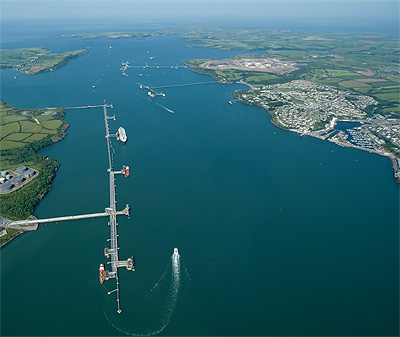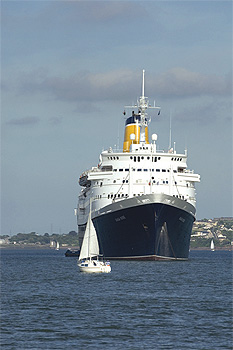Milford Haven Port Authority: A Leading UK Energy Hub
Harbouring ambition
“Milford Haven is the sixth largest port in the UK in terms of cargo and was originally established in 1958 as a trust port to support the oil industry coming into the port area from the Middle East,” reveals Ted Sangster, chief executive at Milford Haven Port Authority.
“Today the port encompasses 60 square miles of waterway, 177 miles of coastline and handles 35 million tonnes of cargo each year.”
Along the waterway, 25 per cent of the UK’s refined products are produced at the Chevron and Murco refineries – the Authority’s customers. There is also an oil terminal in the port run by  SemLogistics, which rents out its tanks and is the largest oil tank facility in the UK, showing a 15 per cent increase in shipping this year. Speaking about the Authority’s current standing, Ted comments: “Turnover last year was £18.5 million and pre-tax profit was £4.7 million. The gross tonnage of shipping in 2008 was 53 million and already this year we’re up three per cent in terms of tonnage of shipping compared with this time last year.”
SemLogistics, which rents out its tanks and is the largest oil tank facility in the UK, showing a 15 per cent increase in shipping this year. Speaking about the Authority’s current standing, Ted comments: “Turnover last year was £18.5 million and pre-tax profit was £4.7 million. The gross tonnage of shipping in 2008 was 53 million and already this year we’re up three per cent in terms of tonnage of shipping compared with this time last year.”
Part of Milford Haven’s success is due to its focus on planning and developing its LNG capabilities to support its two new LNG terminals, Dragon and South Hook. Construction required a great deal of mutual effort. The smaller of the two terminals, Dragon, is a partnership between 4Gas, Petronas and British Gas and represents a £250 million investment. It will bring in up to six million tonnes of LNG annually. The larger terminal, South Hook, is a partnership between Qatar Petroleum, Exxon Mobil and Total, and provides a service between the gas fields in Qatar and Milford Haven. It has the capacity to handle over 15 million tonnes of LNG annually.
Ted provides an update on the newly completed terminals: “Dragon received its first ship on 14th July and South Hook received its first on 20th March. When the Queen and the Emir of Qatar formally opened South Hook it took in the largest LNG ship in the world – the Mozah – and we’ve had eight ships so far in South Hook. We’re being told to expect about another 12 over the summer.”
Continuing, Ted outlines the numerous added benefits that these investments bring: “Owing to the terminals being built and extending the national grid of high pressure pipeline, RWE npower has started work on a 2,000 MW gas-fired power station on the south side of the waterway adjacent to the Chevron refinery. It will produce electricity by October 2012 and will create 2000 construction jobs and a range of supply chain opportunities for local companies. The gas to serve that power station will be brought by a new pipeline 100ft underneath the river, which provides opportunities for Chevron to access the gas in order to reduce energy costs and assist expansion of their production capacity. This is an indication of the way in which developments are cumulatively spurred on by each other.”
Turning his attention to the other refinery, Ted notes that Murco has an intensive investment programme to expand and develop new trades and markets, particularly towards the US: “Murco bought out its site partner Total in November 2007 and in June 2009 we had a VLCC (very large crude carrier) called the Ocana enter the Murco terminal.” – the largest ship to have used the port since 1991.
Ted believes that each new development at the port emerges as a result of a previous progression: “Partly because of being a long established oil and gas port, we now have LNG coming into the equation to provide an added focus and as a result of that we will have a power station. Given the increasing focus on energy related interests, skills and experience in this part of Wales, a number  of other activities are happening.”
of other activities are happening.”
Going into further detail, Ted explains: “Small renewable energy pilot projects are starting in Pembrokeshire, for which our port is acting as a base. That links with developments at the Technium, a facility built by the Welsh Assembly and Pembrokeshire County Council on the waterway to support small business units and academic research focusing on energy. To extend this energy remit, the Crown Estate is looking to license tracts off the UK coast for third stage development of large offshore wind farms.
“The Department of Energy and Climate Change (DECC) has identified what’s required to enable the UK to participate, such as dedicated deepwater port facilities to service these offshore arrays. DECC cites Milford Haven as having strategic advantages for providing such support and consequently the Bristol Channel licence offers a real development opportunity. A number of large companies bidding for that licence have been looking at our port and a former MoD mine depot on the north bank of the port called Blackbridge. We’re working with the council and Welsh Assembly to position the development of Blackbridge in order to support these large-scale developments for offshore marine renewables.”
A decision will soon be made about the preferred developer and work will involve a jetty extension into the deepwater channel as well as demolition of redundant buildings onsite. Afterwards, Milford Haven hopes to fit out Blackbridge with specifications required for the first user, though later the Authority would be looking at development for multiuse – including for cruise ships.
Such progressions confirm Milford Haven’s growing reputation as the UK’s energy capital. For 50 years it has retained major customers in the oil and gas industry, strengthened by the recent LNG investment that provides a springboard for developments. Summarising how he would like to see the port advance, Ted reveals the primary focus: “We want to make Blackbridge productive and supportive towards growth in the port and, for this, offshore renewables is a catalyst because it springboards other opportunities.”
Milford Haven Port Authority
Services: Port services